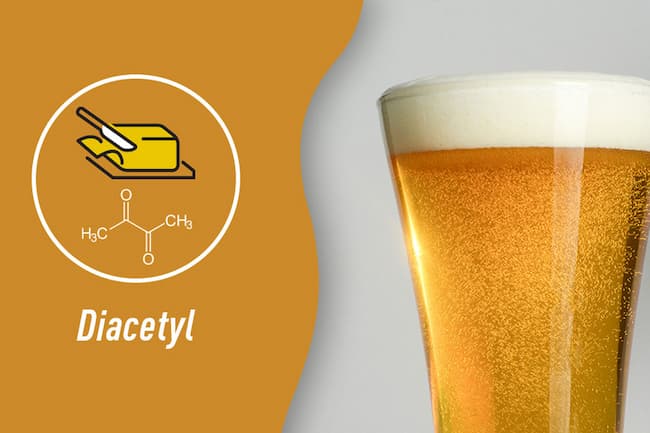Brewers have been struggling with the issue of what causes diacetyl in beer for many years. This chemical compound has a buttery flavor and aroma, and it can be very unpleasant in large quantities.

Some brewers have even been forced to close their businesses because of the presence of diacetyl in their beers. In this article, we will discuss what causes diacetyl in beer and how you can avoid it.
What Is Diacetyl In Beer?
Diacetyl is a buttery-tasting compound that is produced by yeast during fermentation. It is also found in some fruits and vegetables, and it is used as an artificial flavor in many processed foods. Diacetyl can be a desirable flavor in small quantities, but it can quickly become overwhelming if it is not properly controlled.

Diacetyl is produced during fermentation when yeast metabolizes certain sugars. It is also produced when bacteria break down proteins. This compound can be present in both finished beer and brewing wort (unfermented beer).
What Causes Diacetyl In Beer?
There are several factors that can cause diacetyl in beer. The most common one is bacterial contamination. Bacteria produce the compound during fermentation, and it can give the beer a buttery or butterscotch flavor.
Other causes of diacetyl in beer include high levels of oxygen exposure and yeast stress. Yeast produces diacetyl during fermentation, and the compound can be transferred into the beer.
Oxygen exposure can also cause diacetyl to form in beer. This typically happens when oxygen is introduced during the bottling process.
How To Avoid Diacetyl In Beer?
There are several ways that you can avoid diacetyl in beer. Here are a few methods for avoiding the diacetyl in beer. Make sure to check them out.
Avoid Bacterial Contamination
The most important one is to avoid bacterial contamination. This can be done by using clean brewing equipment and sanitizing all of your fermenters and kegs.
Use Healthy Yeast
You should also make sure that you are using healthy yeast strains. If you are using a yeast strain that is known to produce high levels of diacetyl, you may want to consider using a different strain.
Reduce The Amount Of Oxygen Exposure
Finally, you can reduce the amount of oxygen exposure that your beer receives. This can be done by avoiding excessive splashing and agitation during the brewing process, and by packaging your beer in airtight containers.
FAQ’s
Here we have provided you with the most Frequently Asked Questions about what causes Diacetyl in beer.
Q: What is diacetyl?
A: Diacetyl is a buttery-tasting compound that is produced by yeast during fermentation. It is also found in some fruits and vegetables, and it is used as an artificial flavor in many processed foods.
Q: What causes diacetyl in beer?
A: There are several factors that can cause diacetyl in beer. The most common one is bacterial contamination. Bacteria produce the compound during fermentation, and it can give the beer a buttery or butterscotch flavor.
Q: Is diacetyl harmful?
A: Diacetyl is not harmful in small quantities, but it can quickly become overwhelming if it is not properly controlled.
Q: What are the symptoms of diacetyl exposure?
A: The most common symptoms of diacetyl exposure are headache, nausea, and vomiting.
Q: What should I do if I experience the symptoms of diacetyl exposure?
A: If you experience any of the symptoms of diacetyl exposure, you should seek medical attention immediately.
Q: Is Diacetyl Good For You?
A: No, diacetyl is not good for you. Diacetyl can be a great addition to your beer in small quantities, but it can quickly become overwhelming if it is not properly controlled. If you suspect that your beer may be infected with diacetyl, you should seek professional help immediately.
Conclusion
I hope you found this article helpful. If you have any questions about this article, please feel free to post them in the comments section below. For more updates, do visit our chillbeer website.